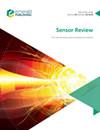用于任意方位裂纹检测的旋转涡流探头的新设计
IF 1.4
4区 工程技术
Q3 INSTRUMENTS & INSTRUMENTATION
引用次数: 0
摘要
目的检测裂纹的方向是涡流无损检测探头发展的主要挑战。基于涡流的技术在检测不垂直于感应电流的裂缝方面受到限制。本研究旨在探讨旋转电磁场法在导电有色金属零件任意取向缺陷检测中的应用。该方法显著提高了对任意方向裂纹的检测效果。提出了一种新型旋转均匀涡流(RUEC)探头。由相似的方形线圈组成的两对激励对在同一提升点上正交排列,从而避免了励磁系统进一步调整以产生旋转电磁场,无需机械旋转并高密度聚焦该场。作为接收器的圆形检测线圈安装在励磁系统的中间。建立了旋转电磁场系统的仿真模型,确定了缺陷区域电磁信号分布的规律和特征。参考Li et al.(2016)利用旋转交变场测量(RACFM)系统检测水下构筑物任意角度人工裂缝的实验结果,对本文模型进行了验证。三维仿真结果表明,所提出的探针可以检测任意方向的裂缝,并保持相同的灵敏度,证明了其有效性。此外,所提出的RUEC探针与开发程序相关联,使我们能够通过分析磁感应信号,在一次扫描中提供裂缝的完整特征,即其长度,深度和方向。本文章由计算机程序翻译,如有差异,请以英文原文为准。
New design of rotating eddy current probe for arbitrary orientation cracks detection
Purpose
Detecting the orientation of cracks is a major challenge in the development of eddy current nondestructive testing probes. Eddy current-based techniques are limited in their ability to detect cracks that are not perpendicular to induced current flows. This study aims to investigate the application of the rotating electromagnetic field method to detect arbitrary orientation defects in conductive nonferrous parts. This method significantly improves the detection of cracks of any orientation.
Design/methodology/approach
A new rotating uniform eddy current (RUEC) probe is presented. Two exciting pairs consisting of similar square-shaped coils are arranged orthogonally at the same lifting point, thus avoiding further adjustment of the excitation system to generate a rotating electromagnetic field, eliminating any need for mechanical rotation and focusing this field with high density. A circular detection coil serving as a receiver is mounted in the middle of the excitation system.
Findings
A simulation model of the rotating electromagnetic field system is performed to determine the rules and characteristics of the electromagnetic signal distribution in the defect area. Referring to the experimental results aimed to detect artificial cracks at arbitrary angles in underwater structures using the rotating alternating current field measurement (RACFM) system in Li et al. (2016), the model proposed in this paper is validated.
Originality/value
CEDRAT FLUX 3D simulation results showed that the proposed probe can detect cracks with any orientation, maintaining the same sensitivity, which demonstrates its effectiveness. Furthermore, the proposed RUEC probe, associated with the exploitation procedure, allows us to provide a full characterization of the crack, namely, its length, depth and orientation in a one-pass scan, by analyzing the magnetic induction signal.
求助全文
通过发布文献求助,成功后即可免费获取论文全文。
去求助
来源期刊

Sensor Review
工程技术-仪器仪表
CiteScore
3.40
自引率
6.20%
发文量
50
审稿时长
3.7 months
期刊介绍:
Sensor Review publishes peer reviewed state-of-the-art articles and specially commissioned technology reviews. Each issue of this multidisciplinary journal includes high quality original content covering all aspects of sensors and their applications, and reflecting the most interesting and strategically important research and development activities from around the world. Because of this, readers can stay at the very forefront of high technology sensor developments.
Emphasis is placed on detailed independent regular and review articles identifying the full range of sensors currently available for specific applications, as well as highlighting those areas of technology showing great potential for the future. The journal encourages authors to consider the practical and social implications of their articles.
All articles undergo a rigorous double-blind peer review process which involves an initial assessment of suitability of an article for the journal followed by sending it to, at least two reviewers in the field if deemed suitable.
Sensor Review’s coverage includes, but is not restricted to:
Mechanical sensors – position, displacement, proximity, velocity, acceleration, vibration, force, torque, pressure, and flow sensors
Electric and magnetic sensors – resistance, inductive, capacitive, piezoelectric, eddy-current, electromagnetic, photoelectric, and thermoelectric sensors
Temperature sensors, infrared sensors, humidity sensors
Optical, electro-optical and fibre-optic sensors and systems, photonic sensors
Biosensors, wearable and implantable sensors and systems, immunosensors
Gas and chemical sensors and systems, polymer sensors
Acoustic and ultrasonic sensors
Haptic sensors and devices
Smart and intelligent sensors and systems
Nanosensors, NEMS, MEMS, and BioMEMS
Quantum sensors
Sensor systems: sensor data fusion, signals, processing and interfacing, signal conditioning.
 求助内容:
求助内容: 应助结果提醒方式:
应助结果提醒方式:


